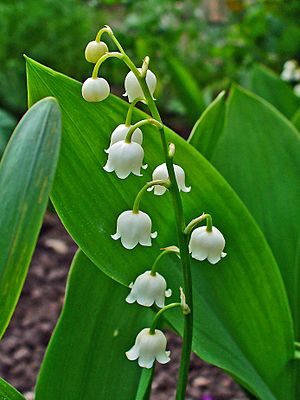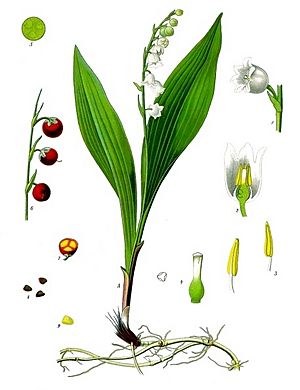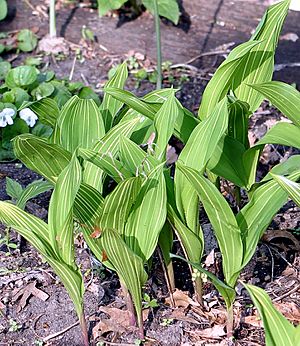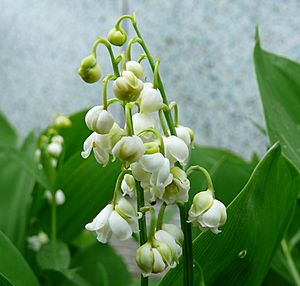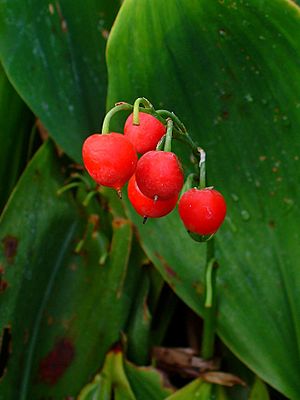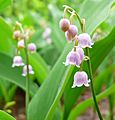Lily of the Valley facts for kids
The Lily of the Valley is a beautiful flowering plant known for its sweet smell. You can find it in the Northern Hemisphere, especially in parts of Asia and Europe. It also grows in the southern Appalachian Mountains in the United States. Its scientific name is Convallaria majalis.
This plant is a herbaceous perennial, which means it has soft stems and comes back every year. While its bell-shaped flowers are lovely and smell wonderful, it's very important to know that the entire plant is highly poisonous. It usually blooms in the late spring.
Contents
What it Looks Like
The Lily of the Valley is a herbaceous perennial plant. It grows in large groups by spreading special underground stems called rhizomes. These rhizomes send up new shoots, sometimes called 'pips', which grow into new plants. This helps the plant form big colonies.
The stems of the plant grow to be about 15–30 centimeters (6–12 inches) tall. Each stem usually has one or two leaves that are 10–25 centimeters (4–10 inches) long. When it flowers, the stem has two leaves and a cluster of 5 to 15 small flowers at the top.
The flowers are typically white, but sometimes they can be pink. They are shaped like bells, about 5–10 millimeters (0.2–0.4 inches) wide, and have a lovely sweet scent. They bloom in late spring, or sometimes as early as March in warmer areas. After the flowers, small orange-red berries appear. These berries are about 5–7 millimeters (0.2–0.3 inches) wide and contain a few seeds. Remember, these berries are also poisonous!
Where it Grows
The Lily of the Valley is originally from Europe, though it doesn't grow much near the Mediterranean or Atlantic coasts. There's a different type, C. majalis var. keiskei, that grows in Japan and other parts of eastern Asia.
In the Eastern United States, a small number of native C. majalis var. montana plants can be found. However, scientists sometimes debate if this American variety is truly native or if it was brought there.
Like many plants that live for many years, the Lily of the Valley can make new plants in two ways. It can spread by growing new plants from its roots (this is called asexual reproduction). It can also make seeds, which are formed when plant cells combine (this is called sexual reproduction).
How it Lives in Nature
The Lily of the Valley likes places with some shade, not full sun. It prefers warm summers and grows best in soils that are silty or sandy. It likes soil that is a bit acidic to moderately alkaline, especially if it has a lot of rich humus (decayed plant material). The Royal Horticultural Society says it really likes slightly alkaline soils. This plant is found in Europe and Asia and can grow in mountains up to 1,500 meters (about 4,900 feet) high.
Some insects use the Lily of the Valley as a food source. The larvae (young forms) of certain moth and butterfly species, like the grey chi moth, eat its leaves. Also, adult and young leaf beetles called Lilioceris merdigera can eat the leaves. They are able to handle the plant's natural poisons.
Growing Lily of the Valley
Many people grow Lily of the Valley in their gardens because of its lovely smell and how well it covers the ground in shady spots. It has even won an award called the Royal Horticultural Society's Award of Garden Merit for being a great garden plant. If the conditions are right, it can spread and form very large groups.
There are different types and cultivars (special versions grown by people) of Lily of the Valley. Some have double flowers, some have pink flowers, and others have leaves with different colors or patterns. Some types also grow larger than the usual plant.
Here are a few examples of these special types:
- C. majalis 'Albostriata' has leaves with white stripes.
- Other types with patterned leaves include 'Green Tapestry', 'Haldon Grange', 'Hardwick Hall', 'Hofheim', 'Marcel', 'Variegata', and 'Vic Pawlowski's Gold'.
- 'Berlin Giant' and 'Géant de Fortin' (also called 'Fortin's Giant') are types that grow larger.
- 'Flore Pleno' has flowers with extra petals, making them look "double."
- 'Rosea' (sometimes called C. majalis var. rosea) has pretty pink flowers.
People have also traditionally grown Lily of the Valley in pots and made them bloom early in winter. This provides fresh flowers for homes and for cutting, even when it's cold outside.
Important Safety Information
It's very important to know that all parts of the Lily of the Valley plant are highly poisonous. This includes the pretty red berries, which might look tempting to children.
If someone accidentally eats any part of the plant, even a small amount, it can cause problems like stomach pain, throwing up, a slower heart rate, blurry vision, feeling sleepy, and red skin rashes.
The plant also contains natural chemicals called saponins. Even though it's dangerous, some people have used small amounts of the plant in traditional herbal remedies. However, it's now mostly used by herbalists as a very carefully controlled herbal remedy. It also has a rare, poisonous amino acid called azetidine-2-carboxylic acid.
Uses of Lily of the Valley
Perfume
The sweet smell of Lily of the Valley is so popular that it's used in perfumes. In 1956, the French company Dior created a perfume called Diorissimo that smelled like this flower. It was designed by Edmond Roudnitska and was a favorite of Christian Dior. Even though the recipe has changed a bit over time, it's still considered a classic perfume.
Other perfumes that smell like or are based on Lily of the Valley include Muguet de Bois (1936) by Henri Robert, Penhaligon's Lily of the Valley (1976), and En Passant (2000) by Olivia Giacobetti.
Weddings and Celebrations
Lily of the Valley is often used in weddings and can be quite expensive. For example, it was part of the bridal bouquet for Catherine Middleton when she married Prince William. Princess Grace of Monaco also chose Lily of the Valley for her wedding bouquet.
In France, at the beginning of the 20th century, a tradition started. On May 1st, which is Labour Day (also called La Fête du Muguet or Lily of the Valley Day), people can sell Lily of the Valley without paying sales tax. It's a symbol of spring.
In Helston, a town in Cornwall, UK, people wear Lily of the Valley on Flora Day (May 8th each year). This represents the arrival of summer. There's even a song called "Lily of the Valley" sung in pubs around Cornwall, which surprisingly came from the Jubilee Singers in Nashville, Tennessee, USA.
Cultural Meanings
The Lily of the Valley has special meanings in different cultures. It was the floral emblem (a special flower representing a country) of Yugoslavia and became the national flower of Finland in 1967.
The Norwegian town of Lunner even has a Lily of the Valley on its coat-of-arms (its official symbol).
For those born in May, the Lily of the Valley is their birth flower. It stands for qualities like humility (being humble), chastity (purity), sweetness, and purity.
The scientific name, majalis or maialis, means "of or belonging to May." Old books about astrology linked the plant to the Roman god Mercury, whose mother was Maia.
In the "language of flowers" (where different flowers have different meanings), the Lily of the Valley means "the return of happiness." There's a story that a nightingale bird wouldn't come back to the woods until the Lily of the Valley bloomed in May.
The famous band Queen also has a song called “Lily of the Valley” on their album Sheer Heart Attack.
Christian Traditions
Two other names for the flower, "Our Lady's tears" and "Mary's tears," come from Christian legends. These stories say the flower grew from the tears of the Virgin Mary during the crucifixion of Jesus. Other stories say it came from Eve's tears after she and Adam left the Garden of Eden, or from the blood of Saint Leonard of Noblac during his fights with a dragon.
The name "lily of the valley" is used in some English versions of the Bible, in the Song of Songs 2:1. However, the original Hebrew words "shoshannat-ha-amaqim" (which means "lily of the valleys") don't actually refer to this specific plant. Still, the biblical phrase might have influenced how the modern plant got its name.
In religious paintings, the Lily of the Valley is a symbol of humility. It is also seen as a sign of Christ's second coming. Some people also believed that the Lily of the Valley represented people's ability to imagine a better world.
Gallery
-
1 May, a painting by Franz Xaver Winterhalter
Images for kids
-
Lily of the Valley plants in Kemi, Finland, in early June
See also
 In Spanish: Convallaria majalis para niños
In Spanish: Convallaria majalis para niños


